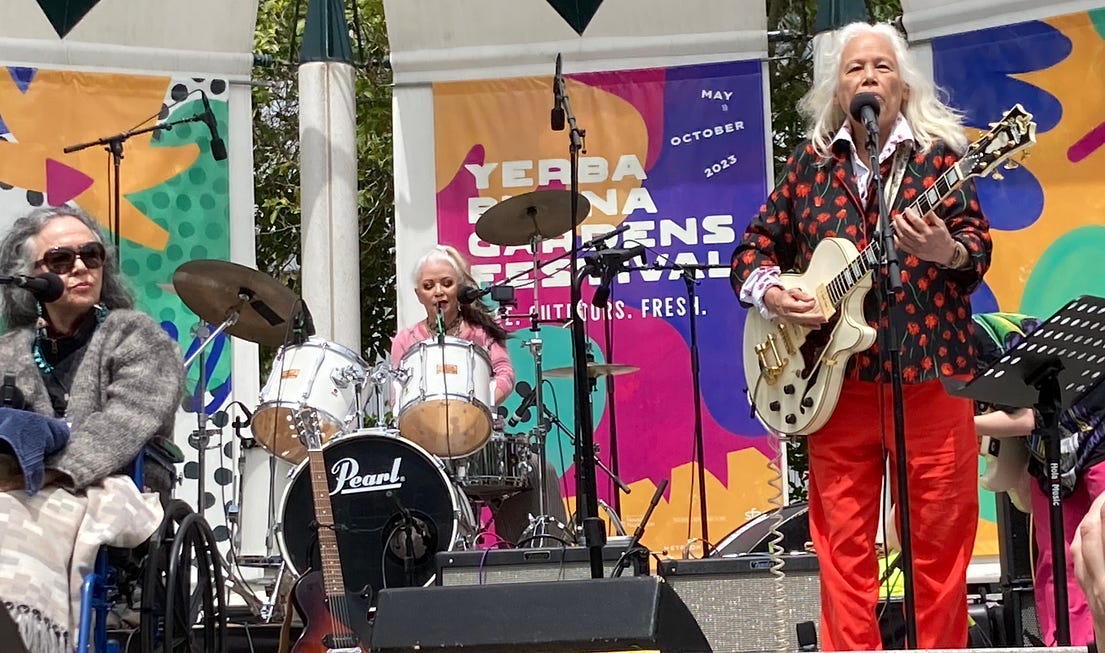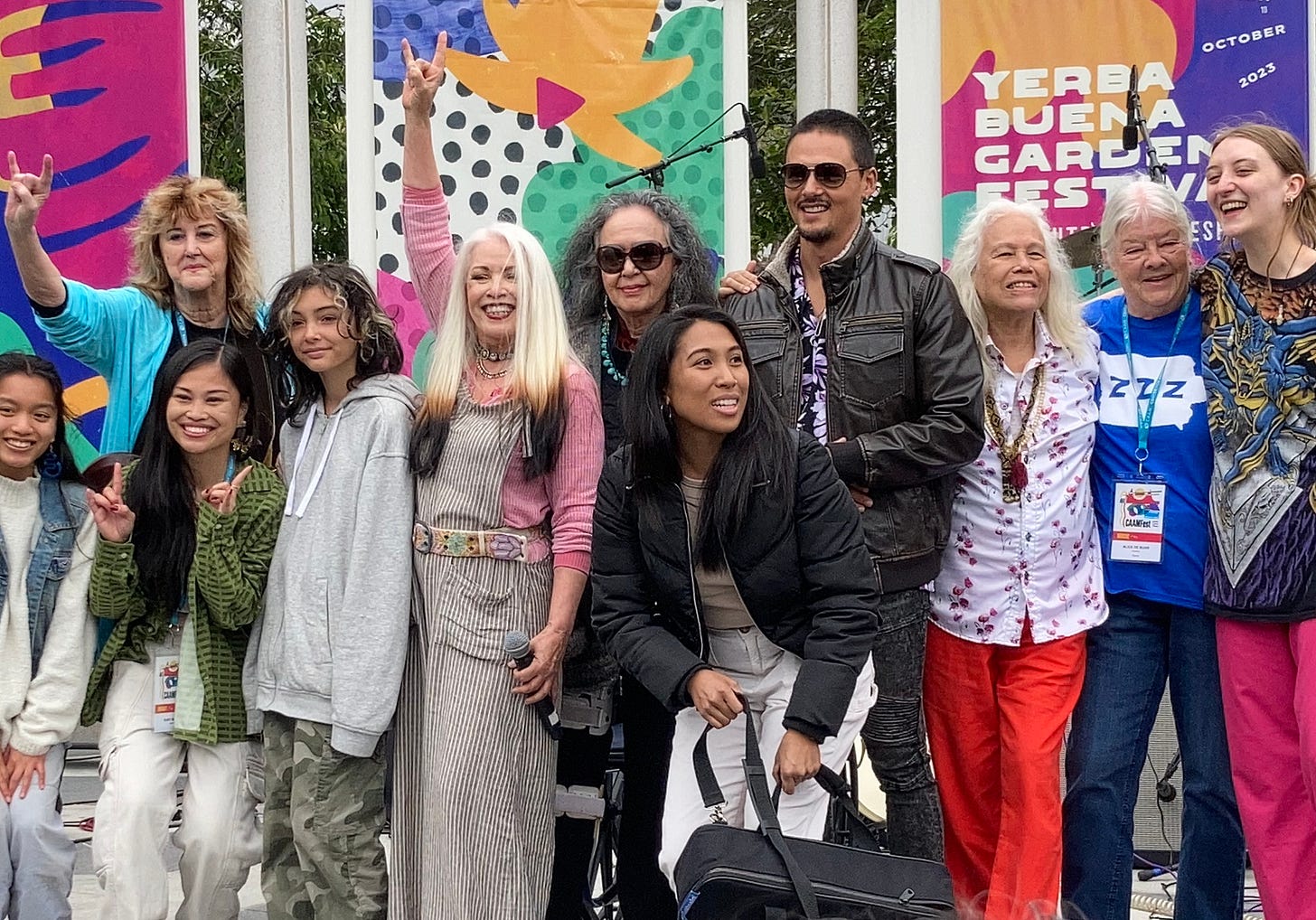A week or so ago, my friend and fellow writer Steve Goldberg tipped me off to something special happening in our backyard.
Fanny was going to give a concert at a small park in San Francisco. Having written about this group and knowing that they are one of the lost legends of early rock, I was all in. On short notice, we arranged to meet at the park.
This is not a review. It is just some observations on the day, along with a little history and background, and my thoughts on how it felt to see this legendary band up close.
I sat with Steve and another friend of his on the lawn. We were quite close to the stage. It started off a beautiful day, though it got a little blustery as the afternoon progressed. The atmosphere was relaxed, friendly, and happy. For Steve’s take on this and other legendary women of rock music, please check out his Substack. He has some great takes on Fanny and Tina Turner, among others, and links to some interesting documentaries.
For those who don’t know, Fanny was one of the first all-female rock bands, and the first to make a significant dent in the charts. Here is my earlier story on them. It’s a short piece that gives a bit of the band’s history and some YouTube clips. I hope you take the time to check it out.
Fanny were founded by two sisters, and some of the other members were classmates from their school days. The band started coming together in 1969 under an earlier name, “The Sveltes,” before locking in their lineup and renaming themselves “Fanny.”
They were not just token women in rock. They were rock and roll pioneers and, in their heyday, jammed with Dylan, Mick Jagger, Bowie, and many other top rockers.
Fanny ended up releasing five major-label albums before they disbanded in 1975. They played as well as, and sounded as good as, any of the big-name male bands who were their contemporaries. They shared the bill with many of the biggest acts of the time. Then they ended up largely being erased from the official histories of rock, not unlike Sister Rosetta Tharpe and other pioneering women.
The Center for Asian American Media had organized the show we saw as part of what used to be called the San Francisco Asian American Film Festival. What was the connection to Fanny? The two founders, Jean and June Millington, are the children of an American who had been stationed in the Philippines and his Filipina wife.
The family moved around a bit, eventually settling in California, where the girls discovered a love of music, learned to play instruments, and started performing together. Another member of the band, Brie Darling, is also part Filipina.
I don’t normally default to racial or ethnic identity for processing things like music or art. Still, it was nevertheless obvious that there was a strong element of racial pride in the celebration of this band. Ironically, back in the 1970s, the fact that they were from an ethnic minority didn’t really register.
I spoke with Brie after the concert, and she said it wasn’t malice; it was just that people had no idea. They had no frame of reference, so they didn’t process it.
Two of the band members, June Millington and Alice de Buhr, were gay, which was also something the society of the time had no way to deal with. Once the band had professional management, they were told to invent fake boyfriends to forestall the possibility of problems related to their being gay. There was a real fear that such a revelation could kill the band’s chances. So they hid it, except from their tight-knit community of fellow musicians.
The fact that they were women was a much bigger deal. Record labels did not take them seriously or give them decent contracts. A few years into their run, their label tried to tart them up and sell them as sex objects, which led to June’s quitting the band, followed shortly by Alice de Buhr. Jean recruited Brie Darling and Patty Quatro, and they lasted another year and a half, but by then, they were burned out.
Much of this history is covered in the 2021 documentary, “Fanny: The Right to Rock”. It is available on various public broadcasting channels and some paid services. I urge anyone who loves rock history to watch it. Here is one link that should work:
Seeing these living legends rock the stage in front of their fans was tremendously moving. Five of the six historical members of the band showed up. Ironically, this exact lineup had never all performed together — they represented several distinct periods in the band’s history. And clearly, many in the crowd knew exactly who they were.
The women are in their 70’s. Jean had a stroke a few years ago and has to sing from a wheelchair, with her bass duties shared between her son and a young woman who is touring with them. June Millington and Brie Darling were most striking, sporting glorious manes of long, snow-white hair. Who says women of a certain age can’t be glamorous?
After two opening acts, Fanny took the stage and played a full set of songs, including a couple from their new album (yes, they recently finished recording their first album in a few decades). Darling and de Buhr took turns on the drum kit. Patty Quatro (one of the famous Quatro sisters and a member of Fanny in 1974-75) played co-lead, along with June.
June joked about being unable to read the set list, but when they got down to it, she could still shred. She also plays a mean slide guitar. They all sang, and the energy got stronger as the set progressed.
This was only the second full set they have performed since getting back together, so you could see them working out the kinks. At one point, they messed up the start of a song, so they just started over. They did it all with perfect aplomb, good humor, and the confidence of 50-year live-performing veterans. The crowd were behind them the whole way.
An informal campaign is underway to have Fanny inducted into the Rock and Roll Hall of Fame. Honestly, the Hall is so tainted by politics, bad judgment, and a history of discrimination that it’s almost irrelevant if this group actually gets in. But it would still be nice to see it happen.
Once again, I want to thank Steve Goldberg. I hope you will check out his column with a perspective on Fanny and other women who shaped rock music.






